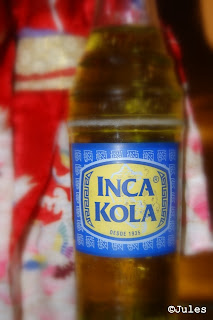Inca Kola, you love it or you hate it. It has been written about it and you may know a lot or less about it too. Why cannot say that Inca Kola is not just a trademark, it is a lovemark. Along with the Irn Bru from Scotland, they are the only two beverages that have beaten Coke in their own countries. But, what I am going to write next, most of Peruvian may do not know about our national soft drink during the World War Second and Japanese Peruvian interment in concentration camps into USA.
I remember, when I was a little girl, I only found Inca Kola at the "Japanese" club. But I always loved Coke so there was a problem because It was not possible to get into the place a bottle of Coke unless I drink it outside before. Well, this measure finished in 1999 when Coke bought Inca Kola. Since then I can find both Coke and Inca Kola.
Go back to our subject, once I asked my father "Why can we only drink Inca Kola inside the club?" and then he answered: "Mr. Lindley (the founder of the company) was one of many people who helped the Japanese during the war so this is our gratefulness to him".
If my memory serves me right, after the attack on Pearl Harbor and Japan's entrance into the World War Second, many Japanese and Peruvian-born Japanese were deported and sent to concentration camps in U.S. because Peruvian President Prado was expected to side firmly with President Roosevelt's Executive Order 9066.The people who stayed in Peru suffered the consequences of war, xenophobia and plunders. Other people did not want to help for fear of being accomplice of spying.
At this point, you might think what is the relationship between Inca Kola and the War?. Well, according to my family and my parent's friends (there is nothing written), the "Japanese" who had business went to the Coca-Cola Company (an American-based company) and shut down the doors to them. So at that time a brand-new company as Mr. Lindley's had to do something and helped "Japanese" with credit facilities.
There might be hidden economic interests but I really appreciate this story because an immigrant from Britain and came to Peru helped another immigrants during war times and built a national empire, a lovemark. It is a relly succes.
There might be hidden economic interests but I really appreciate this story because an immigrant from Britain and came to Peru helped another immigrants during war times and built a national empire, a lovemark. It is a relly succes.












